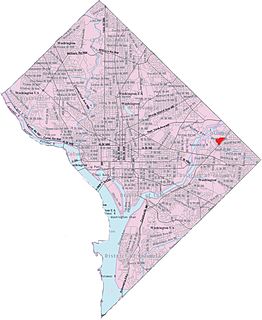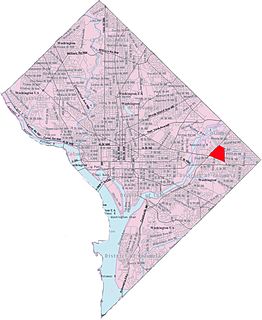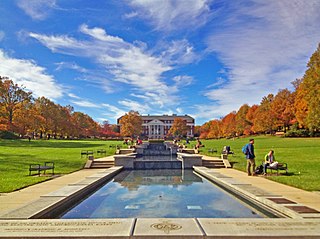Related Research Articles

The St. Marys River is a 22.3-mile-long (35.9 km) river in southern Maryland in the United States. It rises in southern St. Mary's County, and flows to the southeast through Great Mills, widening into a tidal estuary near St. Mary's City, approximately 2 miles (3 km) wide at its mouth on the north bank of the Potomac River, near the Chesapeake Bay to the east.

The International Association of Heat and Frost Insulators and Allied Workers is a trade union in the United States and Canada, founded in 1903. It is affiliated with the AFL–CIO and the Canadian Labour Congress and the North America's Building Trades Unions.

The Cajamarquilla archaeological site is located 25 km inland from the coastal city of Lima, Peru; in the Jicamarca Valley, 6 km north of the Rímac River. It occupies an area of approximately 167 ha, making it one of the largest archaeological monuments in the country. The site itself is now surrounded by several small villages which are encroaching upon, and threatening, its largely unfenced perimeter - despite its nationally 'protected' status.

Benning is a residential neighborhood located in Ward 7 of Northeast Washington, D.C. It is bounded by East Capitol Street to the south, Minnesota Avenue to the west, and Benning Road on the north and east. It is served by the Benning Road station on the Blue Line of the Washington Metro.

Eastland Gardens is a small residential neighborhood, located in northeast Washington, D.C. It is bounded by Eastern Avenue NE to the north, the Watts Branch Tributary to the south, CSX Transportation tracks to the east and the Anacostia River to the west.

Fort Dupont is a residential neighborhood located in southeast Washington, D.C., east of the Anacostia River. It is bounded by East Capitol Street to the north, Fort Dupont Park to the south, Minnesota Avenue to the west, and Fort Chaplin Park to the east and northeast.

Knox Hill is a small neighborhood in Southeast Washington, D.C. It is almost entirely occupied by a public housing complex of the same name. Knox Hill lies in Washington's Ward 8, long the poorest and least developed of the city's wards. Like the neighborhoods around it, Knox Hill is almost exclusively African American.

Shipley Terrace, formerly known as Randle Heights, is a large residential neighborhood in Southeast Washington, D.C., bordering Prince George's County, Maryland. The neighborhood, named after a former public housing complex in the neighborhood, which was largely occupied by low-income housing — primarily walkup and garden unit apartments. This neighborhood now has a mix of townhome communities, large single family home communities, as well as some low-income housing. It is a model neighborhood for the Hope VI revitalization Grant Program.

Civic Betterment is a small neighborhood located in Southeast Washington, D.C., on the border of Prince George's County, Maryland. It is triangular in area, bounded by G and Fitch Streets SE to the north, Benning Road SE to the southwest, and Southern Avenue to the southeast.

Central Northeast, also sometimes called Mahaning Heights, is a small neighborhood located in Northeast Washington, D.C. with Fort Mahan Park at its center. It is bounded by Nannie Helen Burroughs Avenue to the north, Benning Road to the south, the tracks of the Washington Metro and Minnesota Ave station to the west, and 44th Street NE to the east.

Hillbrook is a neighborhood in Northeast Washington, D.C. It is bounded by Nannie Helen Burroughs Avenue to the north, Brooks Street to the south, 44th Street NE to the west, and Division Avenue to the east.

Lincoln Heights is a residential neighborhood in Northeast Washington, D.C. It is bounded by Nannie Helen Burroughs Avenue NE to the north, Blaine Street NE to the south, Division Avenue NE to the east, and 49th Street NE to the west.

McKeldin Mall is a nine-acre quad in the heart of the campus of the University of Maryland, College Park. Named after Theodore McKeldin, the former Governor of Maryland, McKeldin Mall is the largest academic mall in the United States. It has been named one of the most picturesque college campus quads in the nation.
Town Creek is a tributary of the Tred Avon River in Talbot County on Maryland's Eastern Shore.

"M" Circle is a commemorative traffic circle on the campus of the University of Maryland, College Park. Created in 1976 to celebrate the American Bicentennial, the circle is noted for the large floral "M" that sits in its center. The flowers that make up the “M” are replaced twice annually. Around 1,200 tulip bulbs are planted in the fall and after blooming, are then replaced with around 3,500 marigolds or vodka begonias in the spring.
Leeland, Maryland is a defunct settlement in Prince George's County, Maryland. It was once a stop on the Baltimore and Potomac Railroad.
Flather Hall is a dormitory and one of 10 housing options for students at The Catholic University of America. Named for Mary Flather, it was constructed in 1962 and renovated in 2008. On the first floor is a priest in residence and a chapel. It has solar panels on the roof, making it part of the largest solar energy system in the Washington, D.C. metro area. Flather is used primarily to house freshmen men.
Millennium South is a dormitory and one of 10 housing options for students at The Catholic University of America. Built in 2001, it offers suite- and apartment-style options. With Millennium North, it houses 350 upperclassmen.
Opus Hall is a dormitory and one of 10 housing options for students at The Catholic University of America. It opened in 2009 and houses 395 upperclassmen. Opus is the only dormitory building on campus that houses both male and female students; male students reside in the South wing, and females reside in the North wing.
The North River is a tributary of the South River in Maryland.
References
Coordinates: 38°56′19″N76°59′51″W / 38.93858°N 76.99737°W

A geographic coordinate system is a coordinate system that enables every location on Earth to be specified by a set of numbers, letters or symbols. The coordinates are often chosen such that one of the numbers represents a vertical position and two or three of the numbers represent a horizontal position; alternatively, a geographic position may be expressed in a combined three-dimensional Cartesian vector. A common choice of coordinates is latitude, longitude and elevation. To specify a location on a plane requires a map projection.
| This article about a building or structure in Washington, D.C. is a stub. You can help Wikipedia by expanding it. |
